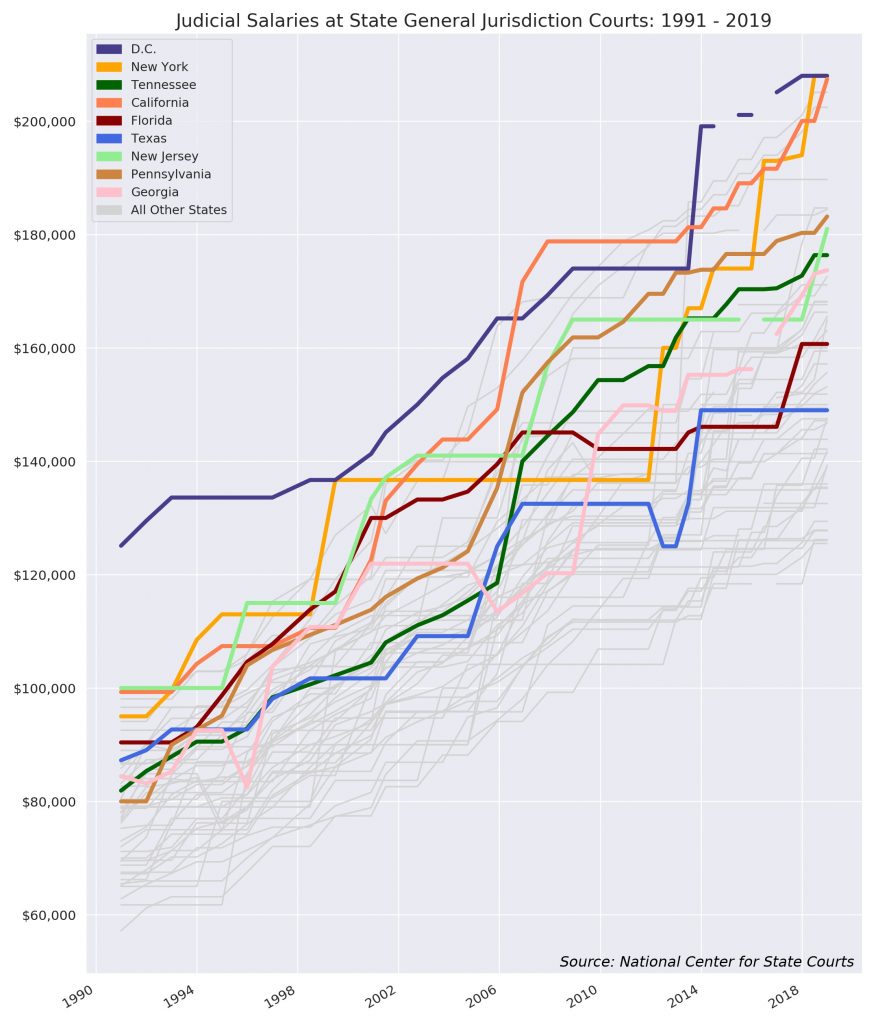Data Snapshot: No Matter How You Slice It, Pa. Judges' Pay Ranks High Nationwide
Pay has risen sharply for trial court judges in New York over the past decade, while the D.C. judges have made the most on average for years. But Pennsylvania judicial pay, which has risen steadily since 1990, ranked in the top 10 nationally across every metric this year. Only a handful of other jurisdictions could say the same.
March 08, 2019 at 01:10 PM
4 minute read
The original version of this story was published on Law.com
The National Center for State Courts (NCSC) has been gathering data on judicial salaries across the country for decades. At the end of January, it published its latest batch of numbers, showing that while pay has been rising sharply for general jurisdiction judges in New York, the dollar still goes the furthest for those on the bench down in Tennessee.
A Law.com analysis of judicial salary data for state courts of general jurisdiction—also called trial courts, the tier just below the state appellate courts—shows that New York judicial salaries have increased the most compared with other states, growing 52 percent over the past decade. Hawaii was not far behind, with 50 percent growth over the same period. Meanwhile, pay for judges at the same tier in Texas has been flat since 2014.
Going back to NCSC numbers from 1991, the data show that judges in Washington, D.C., have had the highest pay on average. However, according to a ranking that the center compiles based on cost-of-living data from an organization called C2ER, trial court judges in Tennessee have gotten paid the most in real terms for at least the past five years.
But Pennsylvania judicial pay, which has risen steadily since 1990, ranked in the top 10 nationally across every metric this year. Only a handful of other jurisdictions could say the same.
According to the NCSC, Pennsylvania Supreme Court justices' annual salary of $211,027 ranks seventh among states' highest courts nationwide.
Pennsylvania's $199,114 salary for intermediate appellate court judges—those on the Commonwealth and Superior courts—ranks fifth among similar courts across the country.
And Pennsylvania trial court judges make $183,184 per year, which puts them at No. 9 nationally. In addition, those judges have the sixth-highest trial court salaries in the country after adjusting for cost of living ($177,676), ranking behind only Tennessee, Arkansas, Georgia, Illinois and Delaware.
The National Picture
William Raftery, a senior analyst at the NCSC, noted that the increase in pay for New York judges came only after 12 years of stagnation—which the chart above illustrates. In 2015, New York's Commission on Legislative, Judicial, and Executive Compensation recommended a pay increase that pegged the salary of New York trial court judges to the same amount paid U.S. district court judges, effective April 2019. (The recommendations were adopted absent an override from the legislature.) U.S. district judges were paid $208,000 annually in 2018.
The numbers are reported by different agencies for each state, and the NCSC doesn't mandate how the states aggregate their numbers if there is any variation in pay between different courts within the state. That can make a comparison somewhat more nuanced, said Blake Kavanaugh, who was in charge of gathering statistics for the NCSC this year. Some years, a jurisdiction may not respond, leaving a gap in the data.
While the trend line in the chart above shows salaries rising for state trial court judges over time across the country (no state has reported a pay decrease any year since 1991), importantly, the figures have not been adjusted for inflation. Overall, the mean salary for judicial positions in January 2019 increased less than 1 percent from July 2018, the NCSC noted in a press release announcing the new numbers.
Raftery added that the pay data also don't take into account how much of judges' salaries are paid automatically into health care plans or pensions. “In some instance, the judges come out a little bit worse for wear,” he said.
This content has been archived. It is available through our partners, LexisNexis® and Bloomberg Law.
To view this content, please continue to their sites.
Not a Lexis Subscriber?
Subscribe Now
Not a Bloomberg Law Subscriber?
Subscribe Now
NOT FOR REPRINT
© 2025 ALM Global, LLC, All Rights Reserved. Request academic re-use from www.copyright.com. All other uses, submit a request to [email protected]. For more information visit Asset & Logo Licensing.
You Might Like
View AllTrending Stories
Featured Firms
Law Offices of Gary Martin Hays & Associates, P.C.
(470) 294-1674
Law Offices of Mark E. Salomone
(857) 444-6468
Smith & Hassler
(713) 739-1250










